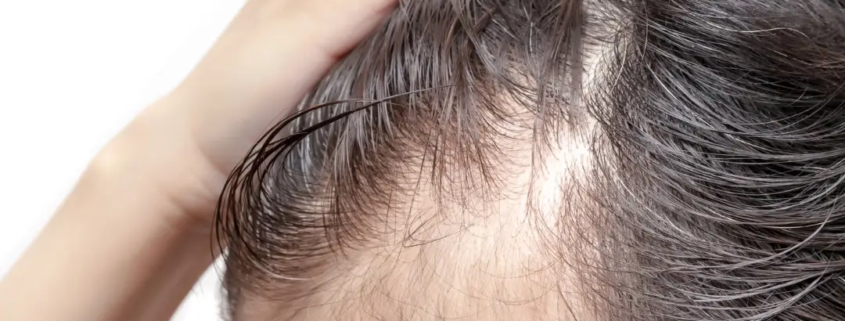How to tell if Hairline is Receding?
Introduction
Your hair is a big part of how you present yourself, but as time goes on, things can change. One common type of hairline change we often see is a receding hairline. In this guide, we’ll dive into what it is, how to spot it, its stages, why it might happen, and treatment options. We also look into the difference between a normal and receding hairline.
What is the receding hairline?
A receding hairline is a common type of hair loss that affects both men and women. The receding hairline starts at the temples and moves towards the top of the head. It’s more common in men, but women can also experience hair loss due to this.
Genetics plays a big role. If there’s a family history of this condition, chances are higher that you might have it too. Certain genes make hair follicles sensitive to a hormone called dihydrotestosterone (DHT). Increased DHT level leads to hair loss and hair thinning. Beyond genetics, hormonal changes during puberty, pregnancy, or menopause can trigger it. Medical conditions like thyroid disorders or stress, poor nutrition, and lifestyle also contribute.
How to tell if your hairline is receding? Signs to Look for!
Detecting a receding hairline early can help in managing the condition pretty well. Here are some signs to look out for:
1. Thinning hair: Noticeable thinning of the hair around the temples and forehead area.
2. Widening forehead: The hairline starts going higher on the forehead. It makes the forehead look bigger.
3. Receding temples: The hairline recedes at the temples, creating an “M” or “V” shape.
4. Bald spot: Small bald patches may appear on the crown of the head.
Knowing your hairline better means understanding why hair might be falling out. One common cause is androgenetic alopecia, also known as male pattern baldness. It starts with a gradual thinning of the hair and a receding hairline.
Another possible cause of a receding hairline is traction alopecia. Traction alopecia happens when people wear tight hairstyles like ponytails, braids, or buns. In conclusion, detecting a receding hairline early is crucial for effective management. By understanding and spotting the signs of a receding hairline you can take action early.
What Does a Receding Hairline Look Like?
A receding hairline can vary in appearance depending on the stage of hair loss. In the early stages, you may notice a slight thinning of the hair around the temples. As the condition progresses, the hairline moves back more, making a clear M or V shape. In severe cases, the receding hairline may leave only a narrow strip of hair across the crown of the head. Explore more about receding hairline in our informative “Mature Hairline vs. Receding” article.
Top 5 Reasons Why Your Hairline is Receding!
Receding hairlines can happen due to various factors. Here are five common reasons why your hairline might be receding:
1. Genetics: Family history determines whether you will experience a receding hairline or not.
2. Hormonal changes: Imbalances in hormones. Especially the male hormone dihydrotestosterone (DHT) can contribute to hair loss.
3. Aging: As we age, hair follicles become less active. It leads to hair thinning and a receding hairline.
4. Stress: Chronic stress can disrupt hair growth cycles. It causes hair loss and a receding hairline.
5. Haircare practices: Using strong products can hurt your hair roots. Lots of heat or tight hairstyles can also wreck your hair.
What are the stages of receding hairline?
A receding hairline goes through stages, showing how much hair you’re losing at each step. While the exact classification may vary, the stages are generally classified as follows:
Stage 1: Minor hairline recession at the temples.
Stage 2: Further recession of the hairline at the temples, forming an M shape.
Stage 3: More significant hairline recession, creating a deeper M shape.
Stage 4: Hairline recession further back, forming a U shape.
Stage 5: Receding hairline reaches the crown area, creating a more pronounced U shape.
Stage 6: The Hairline recites, leaving a narrow strip of hair across the crown.
Stage 7: The most severe stage, with extensive hair loss on the crown and remaining hairline.
What are the treatment options for receding hairline?
Worried about your receding hairline? There are ways to slow down hair loss and help your hair grow back.
1. Medications: Certain Medications help with hair loss and receding hairlines. Minoxidil and finasteride are often used in hair loss treatments.
2. Hair transplant: This method helps hair restoration in the affected area. Discuss options with a specialist for suitability and outcomes.
3. Laser therapy: This non-invasive treatment involves using light therapy to stimulate hair growth. This non-invasive treatment involves using light therapy to stimulate hair growth.
4. Micropigmentation: It is a cosmetic procedure. In that experts use tiny dots of pigment to create the appearance of a fuller hairline.
5. Platelet rich plasma PRP therapy uses concentrated platelets to promote hair regrowth.
Difference between the Normal hairline vs Receding hairline!
Let’s check out how a normal hairline is different from one that’s receding:
Normal Hairline:
a) Hair Density: A normal hairline maintains a consistent density.
b) Position: It sits higher on the forehead.
c) Shape and Pattern: Normal hairlines have a consistent U-shape or a slight widow’s peak.
d) Age and Genetics: Normal hairlines maintain their pattern throughout adulthood.
e) Progression: A normal hairline remains stable over time.
Receding Hairline:
a) Hair Density: A receding hairline shows a gradual loss of hair along the frontal hairline.
b) Position: It often starts at the temples and receding backward.
c) Shape and Pattern: It might exhibit a more pronounced M-shape or receding corners at the temples.
d) Age and Genetics: A receding hairline is often linked to genetic predisposition. It is often noticeable as individuals age.
e) Progression: It shows a progression of hair loss. Frontal hair starts thinning and moving backward.
Conclusion
A receding hairline concerns lots of folks. But if you know what signs to spot and how it’s unlike a regular hairline, it can ease your worries. Figuring out why it’s happening and learning about treatments can give you choices on how to deal with it. Consider a hair loss DNA test for personalized insights.
Learn more about the HairLife DNA test or drop us a word by filling up the form below.
Frequently Asked Questions
Can women experience a receding hairline?
Yes, women can also experience a receding hairline, although it is more common in men.
Is a receding hairline a sign of hair loss?
Yes, a receding hairline often indicates hair loss. It can be an early sign of male pattern hair loss.
Is a receding hairline the same as a mature hairline?
Not exactly. A mature hairline might resemble a receding hairline, but they’re different.
At what age can a receding hairline start?
A receding hairline can start as early as the late teens or early twenties. It is more common as individuals reach their thirties or forties.
Book a consultation
Simply fill in your details in the form below and we’ll get in touch with you shortly.





